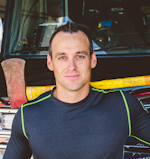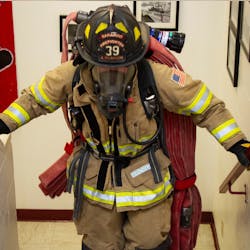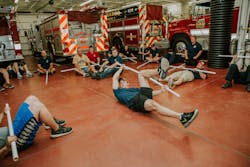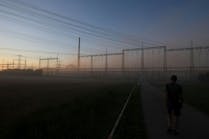Health & Wellness: Combining a Tactical Fitness Program with Training
It is important to make sure that you are capable physically of doing your job, but for most departments, one of the key issues in addressing this isn’t equipment, effort, education or even motivation. It’s time. For career departments, the list of tasks that must be completed is endless. Combination and volunteer department meeting nights include multiple things to train on in a very short period of time. Sometimes agendas and plans are built out months, if not years, in advance, with very little room for adjustments.
This creates the problem: We must support our tactical athletes in their physical capability and wellness, but we don’t have the time for workouts. Luckily, the solution is something that we do better than many others: training.
We all have physically natured training topics consistently in our mind that we know that we must get into, such as air consumption, hose movement, search, RIT and firefighter survival. The solution is right there. By adding compound movements that mimic fireground operations, you can make training more effective and beneficial for firefighters and also promote performance strength.
Mobility
With what movements is it most important to start, and how can you implement them?
All tactical athletes (fire, EMS, law enforcement, the military) have issues that result from the same areas of the body being strained or overworked. Most commonly, these are the knees, lower back, hips and shoulders. Addressing these areas takes a twofold approach: increasing mobility in each area and improving movement or strength around it. (Chances are you had either pain or an injury in one of those areas in your career.)
First consider mobility, or more simply put, moving better. If you can move more efficiently, faster and more effectively in your gear, would you perform better? Would you have less risk of injury? The best way to build on this is dynamic warmups, or preplans, and static stretching, or rehab. This type of implementation does two things for the tactical athlete: improve performance and reduce risk of injury.
In your training plans, these must be short and to the point. This is a great way to start the first 5–7 minutes of training, particularly for the training plans that you create that are more work-intensive.
Options for dynamic movements include standing knee hugs, lunges with a torso twist, and high planks or walking planks. The goal of these movements is to get the body ready to perform. Muscle activation is key to high performance.
For training plans that are more classroom-, lecture- or meeting-based, start with a rehab-based training, such as bird dogs, knee hugs on your back and child’s poses. The goal is to lengthen the muscles, release tension and reduce inflammation.
As is true for any training that we do in the fire service, for this training to work, discipline absolutely must be present. If you don’t put in the effort or it isn’t done consistently, time is wasted.
Incorporate into training
Once the proper pre-plan or rehab training is done, it’s time to implement it into an already existing training plan. Let’s be very clear, this should 100 percent complement a current training plan, and it should help support the physical nature of the training plan, not replace it. You or your training officer must decide where it fits best. For example, if you would like to begin training with air consumption, look at activities that are involved in the use of SCBA that are physical in nature. You could utilize any combination of movements, such as pulling, pushing, swinging or lifting, to create a performance plan that supports proper technique, such as what should be used in patient lifts and drags. You then can build that structure into the training.
Everyone should practice low-air-consumption techniques once the vibe alarm goes off. Until that point, you could properly deploy a ladder (full body and core strength) and perform a rescue drag for approximately 50 feet on a 200-lb. dummy (core and upper body strength if crawling, more lower body and core if standing). Continue these evolutions until your low-air alarm goes off. To add some excitement to it, see who on each shift, company or department can make their air last the longest.
In reality, you likely already do something similar to this. To see improvement, it now is about fine-tuning the movements to develop proper form and technique as well as being deliberate with where effort is placed and what you specifically attack.
When you lift anything from the ground, instead of simply bending down and picking it up, it’s about engaging your back and firing from the glutes and hamstrings. This technique increases strength and protects the lower back area.
When crawling and pulling, it’s important for you to put an emphasis on your core and torso. This enables you to avoid straining your lower back or shoulders.
For a training plan that involves search techniques and applications, start in full PPE and raise a ladder from the shoulder position to overhead for 60 seconds. Then, immediately make entry and jump right to a VES or forcible-entry search. Ensure that each team gets multiple repetitions. What you are applying here is called a pre-exhaust under a lower load. You are firing muscles at a high level right before you use them at a high capacity, such as during a rescue or when making entry. You want to think about time under tension or being under load for 45–50 minutes during a training that’s physical in nature. This is where you truly can see an improvement in performance.
Many changes occur after this period of time. Testosterone drops and cortisol rises, which in terms of human body performance means that you are better off to be done at this point (if it’s training). Any training that takes less than 45–50 minutes and you miss out on some of the benefits that are gained from adaptations and changes that your body can experience when it is put under load or stress.
Strength levels should be found and improved upon in training, not during real emergencies. Thinking about form or technique while in stressful situations isn’t an effective way to get better as a person or a department. You should do the job when you’re on the job; the training is to support you in learning how to make improvements before you put what you’ve added to use.
A marathon, not a sprint
This must be a long-term approach, and this is where discipline comes in. You must push past the moans and groans of having to do more, to work harder. (Even to clean or wash gear, fill air, etc. Those must be there as well.) Think about it like this: Michael Phelps spent 3–4 days per week in the gym during the offseason to support what he needed to do in the pool. Tom Brady spends 3–4 days per week in the gym during the offseason to support what he needs to do on the field. Having a proper strength and conditioning plan is an essential foundation to long-term high performance for tactical athletes. This plan complements the training program but doesn’t replace it.
I will strength train until the day that I die. It’s all about seeking physical failure to allow your body to adapt and to improve over time. I love it. It is such a major part of who I am and my passion. However, I will be 100 percent transparent: Some days, I don’t feel like training, either in the gym or at the firehouse. What do I do on those days? I do it anyway and remind myself why I chose this job and who is counting on me to be able to execute at my highest level. I never want to look back and ask myself, “What if?” It might not be the best workout, or I might not perform the best at training, but by choosing to always work toward improvement and not be content with just “showing up,” I will excel in the long run.
Again, it takes time. It can be your best friend or your biggest obstacle, depending on how you use it. Push to always find ways to improve. Sometimes this can get difficult, because you must identify your weaknesses to improve, but doing so will make you and your department better now and over time.

Brandon Green
Brandon Green is a captain with the Baraboo, WI, Fire Department and lead trainer for the department’s tactical fitness program. He is an instructor for the Madison College fire academy and a coach with the BEDYNAMIC training program. He is a graduate of the World Instructors Training School, which is recognized by NCCA, ACE and IACET, and has been coaching and training for 15 years. Green founded his own fitness system and fitness facility, and he trains all walks of life, from people who have neuromuscular diseases to professional athletes, but he specializes in tactical fitness. You can contact Green at [email protected].







